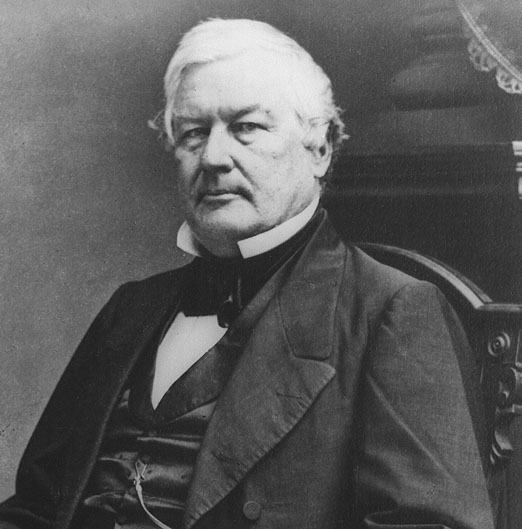Search This Blog
Thursday, January 5, 2012
Millard Fillmore
Served as president from 1850-1853
Era: Westward Expansion Era
American Identity and Culture
Through the abolitionist movements that went on during Millard Fillmore’s presidency, many literature and artworks also came from this time. In 1852 Harriet Beecher Stowe wrote a book that followed the life a slave in the south. The name of this book was Uncle Tom’s Cabin. The book followed the conflicts and the life between a slave named Tom and his brutal white slave owner named Simon Legree. This book caused many controversial issued on slavery and is believed to be one of the leading reasons to the American Civil war. Another book that was written during Millard Fillmore’s presidency is the Impending Crisis of the South. This book was written by Hinton R. Helper who wrote it in 1857. This book was also an attack on slavery. In this book, Hinton R. Helper demonstrated the bad parts of slavery and how it severely limited their economy. The south wanted to quickly ban the book but instead it was distributed to the north by abolitionists.
Economic Transformations and Globalization
During the presidency of Millard Fillmore, Gold was discovered in the areas of California. This gold brought thousands of immigrants and migrants from all over the world. People from almost every country came to California in search for the gold. This major rush of people gave a great reason for the United States government to annex California as a state. The sewing machine was also invented at this time. In 1851, Isaac Merritt Singer patented the sewing machine together. He created new sewing machine from a rotary one that he saw being repaired in a shop in Boston, Massachusetts. There he combined elements of many different machines and used the foot pedal and power into the machine. Howe also had a machine that was created previously from his. He sued Singer in court and made Singer pay him $1.15 per machine that was created.
Environment
During the years of Millard Fillmore’s presidency many Indians that lived on the Great Plains had to leave their lands. Many of them agreed to leave their land and give it to the Federal government in exchange for reservations that were made. The federal government had them move for the building of a transcontinental railway that ran from either the north through Chicago or through the south through Louisiana. The distribution of the land was also made in the different Acts that were created. Many Native Americans were forced off of their lands and moved even farther westward. The Industrial Revolution was also still going on during this time period. People still lived in poor areas and more and more inventions were created during this time.
Politics and Citizenship
The Compromise of 1850 was a large compromise that had a large effect in the United States. It was written up during the time of Millard Fillmore’s presidency and it had California enter the United States as a free state. It also declared that the two new territories that were acclaimed be settled by popular sovereignty. The territories of Utah and New Mexico were acquired and the settlers there would have to decide whether those territories would be slave state of Free states through the popular vote. The slave trade would also be banned in the areas of Washington DC but people could still have slaves there, in the District of Columbia. The compromise also settled the boundaries of Texas and fixes their debt of $10 million dollars as compensation for lost of their land. The Fugitive Slave act was also a major legislation that was passed to enforce slavery in return for the annexation of California as a free state.
Slavery and its legacies in North America
During the presidency of Millard Fillmore, many slavery movements went on. The Compromise of 1850 was also created during this time. This compromise had many parts that were put into work. The compromise was written by Henry Clay who wrote it up after the Extremist meetings in Nashville in 1850. The Compromise of 1850 put into use a new Fugitive Slave law in which it was also enforced furiously. This new fugitive slave law had strict enforcement in which people were to track down slaves in the northern states and force them back into the south with their slave owners. Another part of the Compromise of 1850 was that California was to be entered into the Union as a free state. Instead of being a slave state, they put it into the Union as a free state. The south although, accepted the loss of another slave state because of the strict enforcement of the fugitive slave law.
War and Diplomacy
Millard Fillmore was extremely active in the areas around Asia and the Pacific; he was especially active in the areas of Japan. He kept up many trading routes with Japan and China and also the rest of Southeastern Asia. Millard Fillmore also stuck on foreign affairs with Cuba. The Compromise of 1850 which secured the slave states and free states had no right to add anymore slave states and because of this, the south wanted to gain more slave territories and therefore turning towards Cuba. Venezuelan Narciso Lopez got a small force of American southerners to gather and join his army to invade Cuba. Lopez failed his first invasion and tried again a year later but failed once again after Spanish troops had blocked them off from the island of Cuba. Fillmore was unable to stop Lopez from going because he was able to sneak out of America by sailing from New Orleans.
Subscribe to:
Post Comments (Atom)

No comments:
Post a Comment